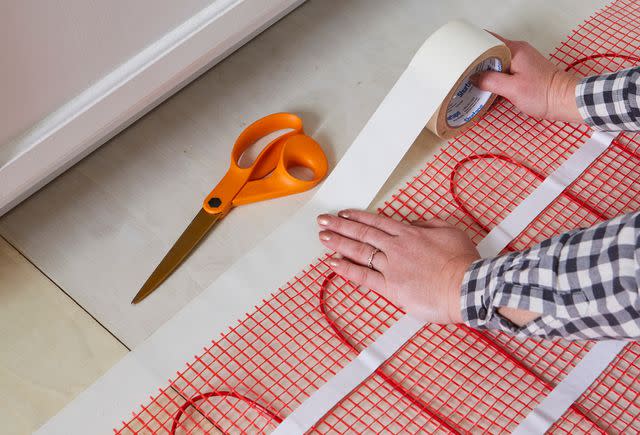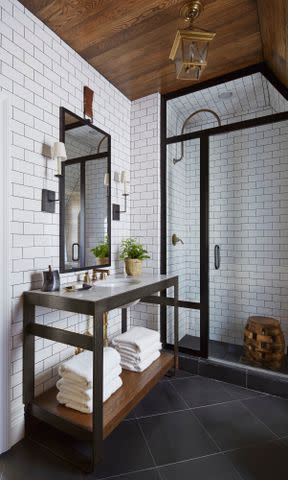10 Things to Know Before Installing Heated Floors
Here's what you need to know before investing in radiant heat flooring for your home.

Astrid Templier
Imagine stepping on warm, gentle flooring that doesn't harbor dust mites or breed mold and saves you money on your heating bills. There's no denying the immense benefits of radiant heat flooring systems, but before you embark on this installation, there are a few basics you may want to consider.
From types of heated flooring to how much you can expect to spend on the installation, our overview will help you decide if this flooring is right for your home. Read on to learn more about this system's installation, timeline, and application.
Related: Types of Flooring: How to Choose the Best Option for Your Home
Are There Different Types of Heated Flooring?
There are two main types of radiant heat flooring: Hydronic and electric. A hydronic flooring system uses hot water tubes to emit heat, while an electric system uses zigzagging loops of electric wire.
Hydronic systems typically cost more up front, but are cheaper to run. You'll save more in initial costs with an electric system, but will likely pay more over time with an electric system. Aside from the cost factor, you likely won't notice a difference between the two once the flooring is installed.
What Are the Best Rooms to Install Heated Floors In?
Kitchens, bathrooms, and bedrooms tend to be best-suited spaces for heated floors. And since underfloor heating works from the ground up, it may also provide a more even heat distribution for spaces with high ceilings.
Related: The Best Bathroom Flooring to Consider for Your Remodel

Stacy Zarin Goldberg
Which Flooring Materials Can I Use?
Ceramic and stone tiles, wood, laminate, vinyl, rubber, and carpet are all be acceptable choices for floor covering on top of a radiant heat system. However, it's best to check your manufacturer's recommendations to ensure you pick the right fit. For example, some carpets with a thicker pile may be too insulated, trapping an underfloor's heat, instead of emitting it into your space.
Related: The 10 Best Vinyl Plank Flooring Options of 2023
What's the Average Cost?
There are two costs associated with heated flooring. The first major cost is the installation fee: This is how much you'll pay up front to have the actual floors installed. The second cost to consider is how much you'll pay to run the system on a daily basis.
The average cost of installing heated floors will depend on whether you install hydronic or electric-based radiant flooring. Hydronic systems can run $7 to $22 per square foot, while electric systems can cost between $8 to $15. Typically, you'll pay more up front for hydronic systems, but save on day-to-day use costs, while electric systems cost less to install, but are usually more expensive to run on a daily basis.
Daily costs are totally dependent on your location and electrical situation; it can cost anywhere from about $1.50 to $7 per day to run the system.
Editors Tip
Standard heated flooring uses about 12 watts of power per hour per square foot. To calculate the cost of heating a room in your home, try this:
[1] Multiply 12 x the square footage of your space = #A (of watts your system will use per hour).
[2] Convert #A into kilowatts (kW) by ÷ #A / 1,000 = #B (kW)
[3] Multiply #B by your electric company's kilowatt-hour (kWH) rate = #C (your total cost).
Related: Here's How Much It Costs to Install Hardwood Floors

Carson Downing
What Does the Installation Process Look Like?
Installing radiant heat flooring sounds like a daunting task, but it is possible to do it yourself. We've put together an easy do-it-yourself guide, but if you don't consider yourself a handy person, you might want to consider calling the professionals.
If you do the install yourself, it's crucial to prepare your workspace and remove your existing flooring down to the subfloor (if your installation requires this). Depending on your space, only some jobs will require the removal of your existing flooring. When this is done, sweep your area clean to ensure it's free of debris before laying out your electric heating mats or cables. You'll also need to level your floor and connect your electricity to make way for your new flooring.
Attach the heated floor mats to the clean, level floor and check the resistance using an ohmmeter. When the entire heating system has been laid, you'll add the actual flooring material over the top, recheck the resistance, and connect the thermostat.
How to Install Heated Floors for Warm Feet All Year
How Long Does It Take?
Typically, most heated floor installation projects take between one to three days. However, your actual timeline will depend on the square footage of your space and its accessibility. It will likely take longer to do it yourself than if you hire a professional, who could have the project done in a day or two.
What Skill Level Do I Need?
This job requires an intermediate skill level. So, if you're a DIYer going solo on this project, we only recommend it if you have some electrical experience. If not, you may need to consult with a certified electrician. No matter which route you take, be honest with your skill level and ability. If you install the system incorrectly, you may end up with a result that's costly to operate, inefficient, or worse, may not function at all.

Werner Straube
Benefits of Radiant Heat Flooring
One of the primary benefits of radiant heat flooring is the high level of energy efficiency it offers. Since this system releases heat into your spaces through under-the-floor heating (versus through the air), it uniformly heats your floor and the room at the same time. Unlike conventional forced-air heating systems that use vents, a heated floor system generates heat at its bottom, radiating to the rest of your space, objects, and people. This process is also what makes heated flooring more cost-effective, as it offers a cheaper alternative to warm your home for hours at a time using less energy.
Heated flooring is also non-allergenic, as its heat consistently dries excess water quickly, preventing mildew and mold—so it's an ideal choice for those with asthma or allergies. Plus, installing heated floors bumps up your resale value too!
Cons of Radiant Heat Flooring
The up-front cost to install this system can be expensive, especially if you have a large area to cover. And, portions of your floor may be hard to reach, making installation a challenge. For many heated flooring projects, your old floor will need to be pulled up, but some retrofit mat systems can be installed under your existing flooring if you have access to joist bays. In addition, installing heated floors will increase your floor height by about 1/2 inch on top of your subfloor, which could cause uneven surfaces if you don't install the heated floors throughout the entire home.
The Bottom Line
It's tempting to install heated flooring without giving it too much thought—after all, underfloor heat can enhance your everyday living tenfold. But it's best to take this project on only if you have the budget and skillset to see it through. In addition, it's a sound investment to consider if your home is a new build, where you won't be on-site (especially if your old flooring needs to be ripped out) and can squeeze in this upgrade stress-free.
For more Better Homes & Gardens news, make sure to sign up for our newsletter!
Read the original article on Better Homes & Gardens.

